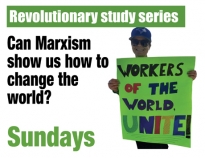Columns
You are here
the Peoples' Social Forum and the united front

September 6, 2014
Thousands of activists converged in Ottawa at the Peoples’ Social Forum (PSF) to discuss the way forward on a number of issues: trade union rights, First Nations land claims and indigenous rights, defending the environment and stopping the pipelines, building solidarity with the Palestinian struggle, etc. The PSF statement issued at the end of the conference encompasses both a call for complete and fundamental change in society and a specific strategy which is about defeating the present Tory government, as a step on the road to that better world we all know is possible:
“We participated in the Peoples’ Social Forum because it is urgent to stop the attacks on democracy, and to free our societies of neoliberal capitalism, imperialism, patriarchy, colonialism, racism, heterosexism, and of the domination of large companies on Peoples. The Peoples’ Social Forum process has allowed us to intensify a convergence of an unheard diversity between our movements….
However, in the short run, we must propel the social movements’ current convergence towards an active, non-partisan role and lead a combative campaign against the Conservatives. As long as the Conservatives impose their idea of society, we will not be able to protect our rights and the environment, and we will not be able to carry out an open debate on what would be a society fair, viable and respectful of its Peoples.”
This statement begins with the maximum program and then focuses on the Tories. There are fault lines if people just insist on the maximum program or if it collapses into "anyone but the Conservatives" electoralism. How can anti-capitalists build broad and united movements around immediate goals that can be won, and at the same time intervene to win people to radical politics and to change from below?
How ideas change
Insisting on some maximum program can never work because it misunderstands the hold of reformist ideas on most people most of the time. Because we live in a capitalist system, where the ruling ideas are those of the ruling class who control the media and the dissemination of ideas in society, it is very difficult for people to break from those ideas. A partial break to support parties like the NDP and to accept the notion that we can work together to reform the system is an important one, and it’s why revolutionaries can never dismiss the large numbers of people who will choose that option over joining a revolutionary organization.
However, as happened in the post-WWI period, many people came to understand, through their own experience, that tinkering with the system wasn’t enough. Revolutionary organizations were able to grow very quickly in a situation where people could see the bloodthirsty nature of the system.
The theory of the united front was developed from the experience of socialists organizing in the period following World War I—the revolutionary upsurges that followed the mass slaughter of working class people on all sides. This was a period where mass revolutionary organizations operated alongside mass reformist organizations. The united front aims to organize the largest number of people in defense of a specific goal—whether that be the defence of trade union rights, to stop an imperialist war, to defend a woman’s right to choose or to stop climate change and environmental destruction—and through the process win people to revolutionary politics and organization.
The united front
Leon Trotsky is the socialist most associated with the united front, and elaborated the theory based on the experience of the international revolutionary left after WWI. As he wrote, “there is an urgent need to secure for the working class the possibility of a united front in the struggle against capitalism. For those who don not understand this task, the party is only a propaganda society and not an organization for mass action.”
In a time when revolutionaries are a minority this necessarily involves working with reformists around specific goals. Socialists try to build mass movements around specific goals because this is the best way of fighting for reforms, and through the process winning people to revolutionary politics: “Sections of the working class belong to reformist organizations or support them. Their present experience is still insufficient to enable them to break with the reformist organizations and join us. It may be precisely after engaging in those mass activities that a major change will take place in this connection…The Communists must not oppose such actions but on the contrary must also assume the initiative for them, precisely for the reason that the greater is the mass drawn into the movement, the higher its self-confidence rises, all the more self-confident will that mass movement be and all the more resolutely will it be capable of marching forward, however modest may be the initial slogans of struggle. And this means that the growth of the mass aspects of the movement tends to radicalize it, and creates much more favourable conditions for the slogans, methods of struggle, and, in general, the leading role of the Communist Party.”
But this is not automatic, so revolutionaries also have to have their own independent organizations: “We participate in the united front but do not for a single moment become dissolved in it. We function in the united front as an independent detachment. It is precisely in the course of struggle that broad masses must learn from experience that we fight better than the others, that we see more clearly than the others, that we are more audacious and resolute.”
Iraq War
The revolutionary left is tiny compared with the 1920s but the united front tactics continues to inform our practice. If we take as an example the anti-war movement that grew up around the wars on Iraq and Afghanistan we can see how the united front approach works in practice.
Many of the coalitions that were built during the lead-up to the war on Iraq shared a common approach. This was based on the understanding that it was both possible and necessary to build a large movement on a narrow basis of unity—anyone who opposed the war on Iraq was welcome in the movement. We didn’t want to exclude people who weren’t deemed to be “radical” enough for the movement.
Insisting that people accept the “maximum program”—i.e. you must identify as an anti-imperialist and an anti-capitalist in order to be a part of the struggle—would have meant a much smaller, ineffectual and elitist movement.
Instead, socialists and others argued that the anti-war movement needed to build broadly. This broad-based strategy is what allowed the anti-war movement to hold the largest anti-war demonstrations globally, to that point in history, on February 15 2013. Many people who became active because they were opposed to killing innocent civilians, perhaps on a religious or pacifist basis, came to see that the Western attacks on Iraq and Afghanistan were part of a larger picture called imperialism. The anti-war movement laid the basis for a much clearer solidarity with Palestinians that has borne fruit in the recent condemnation of Israel, even among more mainstream organizations, around the bombing of Gaza.
From anti-Harper to anti-capitalism
The PSF statement includes the following:
“We do not want a State that supports the Canadian mining companies here and abroad. A State that tramples the rights of Palestinian people by supporting the Israeli regime’s Apartheid, in spite of the numerous international resolutions. We do not want a State that oppresses the First Peoples. We do not want a State increasing militarization and criminalizing dissent.
During this social forum, we have shared the sprouts of a new vision of society, based on social and environmental justice, self-determination of Indigenous Peoples, human rights, democracy, equality between individuals and between Peoples, the inclusion of all generations, solidarity, and a new economic paradigm serving people, not the opposite.”
In the struggles going forward the united front tactic will be important, both in building the largest possible movement to achieve our goals and at the same time building a revolutionary organization that can unite those who see clearly the need, not just for tinkering with the system, exchanging one leader for another, but in mobilizing the 99% to create from below and from the bottom the new society we so desperately need.
Section:










